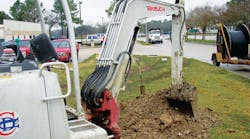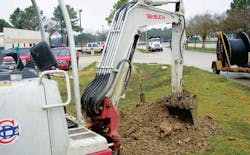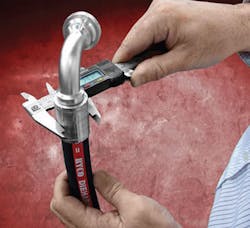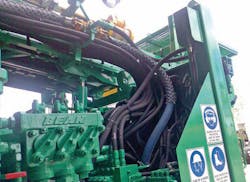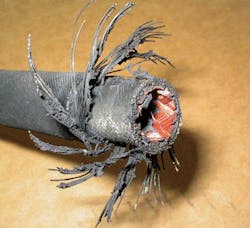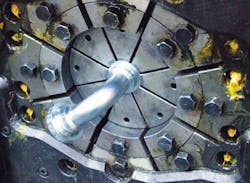Engineering Hose Assemblies for Safe and Reliable Performance
Hose assemblies simplify many issues when designing, building, and maintaining hydraulic equipment. Flexible hoses are easier to route and install, compared with rigid tubing and pipe. They lessen vibration and noise, dampen pressure surges, and permit movement between parts.
And as machine builders continue to push the engineering envelope to meet customer demands for productivity, efficiency, and environmental compatibility, so have the requirements for hose integrity. These include withstanding higher pressures, extreme heat and cold, and a wide range of fluids — including today’s “green” variants. And that’s not to mention the call for longer life despite abrasion, impact, and generally rough operating conditions.
Other challenges hose manufacturers face include developing products that are more flexible, compact, and lightweight, while maintaining safety and durability. Here are some ways to ensure hose integrity and longevity.
Hose and fitting compatibility
Most hoses are manufactured to SAE J517 or EN (European Norm) Standards, the latter based on earlier DIN German standards. These standards predominate in the Americas, Europe, and Australia. Both are also used throughout Asia, though that market is slowly gravitating toward EN specs, primarily because ENrated hose has a higher pressure rating, compared with similar-size SAE hose. This gives greater safety factors should an application not need the highest working pressure. Higher pressure ratings also offer manufacturers a competitive advantage.
A casual observer might view a hose and its end couplings as individual components. But, in fact, they’re critical parts designed to work together in a precisely engineered system. Thus, it takes more than good parts to make good assemblies.
Making a hose assembly means crimping or swaging a coupling just the right amount to produce the locking interface between the hose and coupling. The end connection must be crimped enough to hold on, but not too much to damage the hose or collapse the coupling interior.
A common misconception is that if a coupling is compatible with a hose that meets SAE or EN specifications, the coupling will work with all hose that meets the specs. This is simply not true.
When making or buying an assembly, experts strongly recommend that hose and fittings all come from the same manufacturer. That’s because dimensional tolerances listed in standards are quite broad. Hose not manufactured with tightly controlled dimensions might still meet the standards, but may be difficult to assemble and perform poorly due to compression variations when crimping the coupling.
In short, components are designed and engineered to work together. SAE J517 hose from one manufacturer is usually not compatible with SAE J516 connectors made by another manufacturer. It is the fabricator’s responsibility to consult manufacturer’s assembly instructions — or the manufacturer directly — before intermixing hose and connectors from different manufacturers. But in reality, few manufacturers will sign off on mixed assemblies or warrant performance. And for liability reasons, both fitting and hose manufacturers will deny responsibility in the event of a failure.
Similarly, attaching permanent connectors to hydraulic hose requires specialized crimping or swaging equipment. (Field-attachable connectors, such as screw-on and segment- clamp styles, can usually be assembled without special tools — though many manufacturers provide equipment to assist in this operation.) Assembly equipment f rom one manufacturer is usually not interchangeable with that of another manufacturer.
The STAMPED process
Unless a governing standard or industry certification applies, a good way to select hose and couplings is to use the STAMPED process — endorsed by The National Assn. of Hose and Accessory Distributors (NAHAD). This acronym relates to the seven major areas of consideration. Here’s a look at each.
Size includes inner and outer diameters, and overall assembly length. Hose ID must be large enough to minimize pressure losses and avoid damage to the hose due to heat generation or excessive turbulence. To determine a replacement hose ID, read the layline printing on the side of the original hose. If the layline is painted over or worn off, cut the original hose and measure the inside diameter. Otherwise, size the hose according to a size selection nomograph chart found in most manufacturers’ catalogs.
Hose length can change between +2 and –4% when pressurized. If a hose barely reaches its connections, pressure may cause the hose to contract, stretch, and shorten service life. So make hose lengths slightly longer than the actual distance between connections. However, moving components on equipment may pinch or even sever hose that is too long.
Hose OD becomes important when using support clamps or routing though confined bulkheads.
Temperature relates to both the fluid conveyed and that of the surrounding environment. Most hydraulic hose is rated for a maximum working (fluid) temperature of 200 to 300°F, though some, such as PTFE-based hose, have higher ratings. Exceeding the limit significantly reduces hose life.
Special cold-weather rubber compounds let hose run at temperatures down to –65°F. But care must be taken when routing near hot manifolds and other high-temperature sources. In extreme cases, heat shields or insulating sleeves may be advisable.
Application conditions are obviously an important consideration. For replacement hose, most often a duplicate of the original assembly will suffice. Otherwise, consider where and how the hose will be used, including such factors as:
• Excessive abrasion. While hose is designed with a reasonable level of abrasion resistance, protect it from too much abrasion that can erode, snag, and cut the cover. Exposing the reinforcement significantly accelerates failure. Prevent abrasion by clamping the hose in place to prevent it from rubbing against adjacent surfaces. Some hoses have special abrasion- resistant covers. And users can install metal, plastic, or fabric sleeves over the hose for added protection.
• Electrical conductivity. Most hose with wire reinforcement conducts electricity. For equipment used near power lines, manufacturers make nonconductive versions. Conversely, static electricity can sometimes discharge through the hose wall to surrounding surfaces. In this case, hose with a conductive tube routes electrostatic charges to the end fittings.
• Minimum bend radius. This refers to the tightest bend a hose can tolerate, per manufacturer’s recommendation. Using a smaller radius than recommended will likely harm the reinforcement and reduce hose life.
• Unusual mechanical loads. External forces can shorten hose life. Avoid excessive flexing, kinking, tensile and side loads, and severe vibrations.
• Routing. Though hose is flexible, avoid bending in more than one plane if at all possible. Twisting hose to even a small degree can substantially reduce life. Swivel-type fittings or adaptors may be required to prevent twisting. And when multiple lengths of hose lie next to each other and have considerable relative movements, carriers keep them neatly arranged and prevent tangling or rubbing.
• Suction requirements. Most hydraulic hose is built to handle pressure. Specify special suction hose to handle negative-pressure applications.
Material considerations include the type of fluid being conveyed and its concentration, as well as substances that may attack the hose cover. Hose selection must ensure compatibility if it is to convey special oils or chemicals. The same holds for hose exposed to harsh environments. Substances such as UV light, ozone, saltwater, chemi c a l s , and pollutants can cause degradation and premature failure. For in-depth fluid compatibility data, consult the manufacturer.
Pressure to which the assembly will be exposed is critical to ensuring safety and long life. The most important step in the selection process is knowing system pressure, including pressure spikes. Hose-assembly working pressures must equal or exceed the system pressure including spikes. Pressure spikes greater than the hose’s maximum working pressure will hasten failure. End connectors, like hose, have a definitive pressure rating. Use the lesser of the hose or fitting rating as the maximum assembly pressure rating.
Ends include termination end style, type, orientation, and attachment methods. For replacement, identify end connections using information in manufacturers’ catalogs or technical manuals.
Delivery involves more than when the product arrives on your receiving dock. Define special requirements such as testing, quality, packaging, and cleanliness. For instance, users may want to specify delivery of precleaned assemblies that have been flushed with fluid or compressed air. Cutting, storing, and shipping hose can introduce abrasive particles which, if left unchecked, can damage sensitive components in hydraulic systems. Once an assembly is cleaned, make sure to install protective caps or plugs at the ends until it is installed.
Avoiding failure
Selecting and applying the wrong assembly can be dangerous and even fatal. Personal injuries from hydraulic hose can include high-pressure fluid injection, burns from hot hydraulic fluid, fire and explosions from fluids, and broken bones from a whipping assembly. Hose systems properly selected and used within manufacturer’s guidelines will operate safely and can last for many years.
Improper application is the most common cause of hose failure. Always compare specifications with the application requirements. Pay particular attention to:
• Maximum operating pressure of the hose.
• The hose’s recommended temperature range.
• Is the hose rated for vacuum service?
• Fluid compatibility of the hose.
If these areas don’t match the application requirements, select another hose. And if in doubt, don’t hesitate to call on the manufacturer’s expertise.
Improper assembly and installation is the second major cause of premature hose failure. This can involve anything from using the wrong fitting to poor routing of the assembly. Manufacturers provide training material to help prevent these problems.
External damage can range from abrasion and corrosion to hose crushed by a lift truck. These problems can normally be solved simply once the cause is identified. The hose can be rerouted or clamped, Circle 202 or a fire sleeve or abrasion guard added. In the case of corrosion, the answer may be a more chemical-resistant cover or rerouting the hose to avoid corrosive materials.
Frequent or premature hose failure can be a symptom of equipment malfunction. Always consider this factor, because prompt corrective action can sometimes avoid serious and costly equipment breakdown.
Occasionally, the failure lies with the hose itself. The most likely cause of a faulty rubber hose is old age. Check the hose’s layline to determine the date of manufacture. (For instance, 2Q04 means second quarter of 2004.) The hose may have exceeded its recommended shelf life.
Other factors which reduce assembly life include:
• Flexing the hose to less than the specified minimum bend radius.
• Twisting, pulling, kinking, crushing, or abrading the hose.
• Operating above maximum and below minimum rated temperatures.
• Exposing the hose to surge pressures above the maximum working pressure.
• Mixing hose, connectors, or assembly equipment not recommended by the manufacturer, or not following manufacturer’s instructions for fabricating assemblies.
Maintenance checks
A recommended practice is to perform ongoing visual inspections of equipment and hydraulic components. Hose and fittings should be checked for:
• Leaks at the fittings, ports, and in the hose.
• Exposed, damaged, abraded, or corroded reinforcements.
• Cracked, damaged, or badly corroded fittings.
• Bulges or blisters in the hose.
• Damaged or missing clamps, guards, or shields.
• Any other signs of significant deterioration.
Consider replacing the assembly if technicians spot any of these conditions. Like any component on a piece of equipment, maintain and inspect hoses at regular intervals and replace when necessary.
Greg Brown is Distributor Training & Support Manager at Ryco Hydraulics Houston. for more information, viist ryco.com.au.
